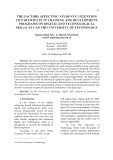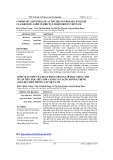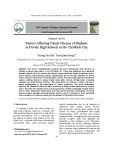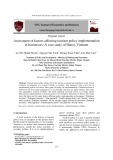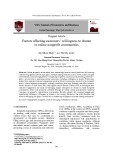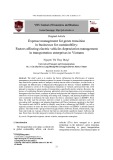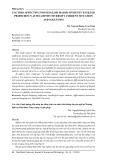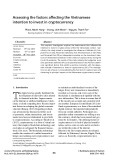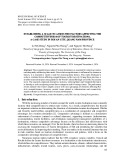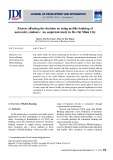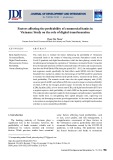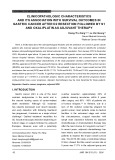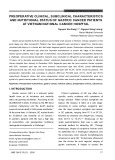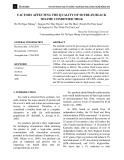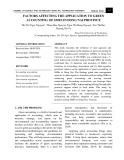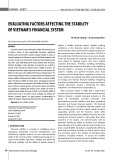
HUE JOURNAL OF MEDICINE AND PHARMACY ISSN 3030-4318; eISSN: 3030-4326
164
Hue Journal of Medicine and Pharmacy, Volume 14, No.6/2024
Factors affecting preoperative nutritional status of gastric cancer patients
at Vietnam National Cancer Hospital
Nguyen Van Dang1,2,*, Nguyen Hong Luong1
(1) Hanoi Medical University
(2) Vietnam National Cancer Hospital
Abstract
Objective: Gastric cancer (GC) sometimes presents as asymptomatic or exhibits only nonspecific
symptoms in its initial stages, resulting in delayed diagnosis and subsequent starvation. Patients with gastric
cancer who had preoperative malnutrition faced a heightened risk of unfavorable clinical outcomes. The
nutritional status was affected by various factors, including the disease’s location and stage, as well as
gastrointestinal symptoms such diminished food intake, abdominal pain, and vomiting. Materials & Method:
Between January and December 2023, the Vietnam National Cancer Hospital performed cross-sectional
descriptive research on 88 stomach cancer patients to elucidate their dietary status and associated factors.
Results: The preoperative malnutrition rates based on albumin, body mass index (BMI), and scored patient-
generated subjective global assessment (PG-SGA) were 34.1%, 29.5%, and 55.7%, respectively. Research has
not found a relationship between nutritional status assessed by PG-SGA as well as BMI with factors such as
age, gender, clinical symptoms, and disease stage. Conclusion: Prior to surgery, GC patients had a very high
risk of malnutrition. Research has not found a relationship between nutritional status assessed by PG-SGA as
well as BMI with any factors.
Keywords: preoperative malnutrition, gastric cancer, nutrition status, factors affecting.
Corresponding Author: Nguyen Van Dang. Email: nguyenvandang@hmu.edu.vn
Received: 9/9/2024; Accepted: 14/11/2024; Published: 25/12/2024
DOI: 10.34071/jmp.2024.6.23
1. INTRODUCTION
Gastric cancer constitutes significant public
health concern due to the increasing incidence
and fatality rates globally [1]. In Vietnam, 17,906
individuals (9.8%) of new gastric cancer cases
ranked fourth in both incidence and mortality
among all malignancies [2]. Moreover, patients with
gastric cancer exhibited a significant prevalence
of malnutrition, and preoperative nutritional
therapy poses a considerable problem [3]. Prior
research indicated that 40-50% of patients with
surgical conditions, particularly those undergoing
gastrectomy, were malnourished at admission [4].
Stomach cancer affects the ability to digest and
absorb food, the tumor secretes substances that
reduce appetite... Thereby reducing food intake
and nutrient absorption leading to malnutrition.
On the other hand, malnutrition affects the body’s
resistance, reducing the body’s ability to fight
diseases [4].
Patients with gastric cancer who presented with
preoperative malnutrition exhibited a heightened risk
of adverse clinical outcomes. In 2010, at St Vincent’s
Hospital Melbourne, Australia, preoperative
malnourished patients had an extended hospital
stay averaging 15.8 days and exhibited a higher
incidence of complications, more than double that of
well-nourished patients [5]. Preoperative nutritional
support in gastric cancer has been shown to reduce
the incidence of surgical site infections, length of
hospital stays, and associated costs [6].
Preoperative nutritional evaluation to identify
undernutrition and offer the chance to enhance
nutritional status. There are many methods to assess
nutritional status such as body mass index (BMI),
Patient Generated Subjective Global Assessment
(PG-SGA) or assess nutritional status through
biochemical indices such as serum albumin or
hemoglobin [7]. Weight and height alone did not
assess nutritional status, but it must be combined
with weight, height and overall size, body structure,
energy and protein reserves, through soft tissues
surface of carotid circumference, subcutaneous fat
layer and muscle, … Among them, BMI was the most
used [8]. PG-SGA was a more specific method of
assessing nutritional status for cancer patients, such
as assessing the presence of symptoms of nausea,
vomiting, diarrhea, dry mouth and taste changes,
sense. This was a comprehensive subjective
assessment performed on all aspects including:
weight loss, decreased food digestion, activity and
function, increased metabolic demands and physical
examination [9]. Albumin was one of the visceral
proteins produced by the liver that was used as a





